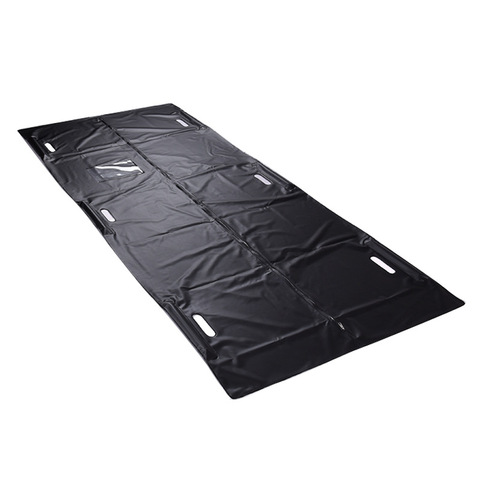
- Standard Body Bags
- Material: Typically made from polyethylene or PVC.
- Use: General use for deceased transport and storage.
- Heavy-Duty Body Bags
- Material: Made from thicker and more durable materials like reinforced PVC or vinyl.
- Use: Used in situations requiring extra durability, such as disaster zones or for transporting bodies with significant trauma.
- Biohazard Body Bags
- Material: Often made from materials that provide protection against biological hazards.
- Use: For bodies that pose a risk of infection or contamination, such as those with infectious diseases.
- Decomposable Body Bags
- Material: Made from materials that decompose naturally over time, such as certain biodegradable plastics.
- Use: For environmentally conscious burials.
- Disaster Pouch Body Bags
- Material: Reinforced with multiple layers, often with handles for easier transport.
- Use: Designed for mass casualty incidents, offering robustness and ease of handling.
- Cadaver Bags with Viewing Windows
- Material: Clear or semi-transparent windows made from plastic.
- Use: Allows for identification without fully opening the bag.
Body Bag Specifications
Colors
- White: Commonly used for standard body transportation and storage.
- Black: Often used for disaster response and high-profile situations to maintain discretion.
- Orange/Red: Typically used for high-visibility applications, such as mass casualty incidents or in areas where easy identification of remains is crucial.
- Blue: Sometimes used in medical or hospital settings.
- Green/Brown: Occasionally used for environmental or eco-friendly burials.
Sizes
- Infant: Smallest size, typically around 30 inches (76 cm) in length.
- Child: Intermediate size, usually around 48 inches (122 cm) in length.
- Adult Standard: Common size, approximately 72 inches (183 cm) in length and 24-30 inches (61-76 cm) in width.
- Adult Large: Larger size for bigger bodies, often around 90 inches (229 cm) in length and 36 inches (91 cm) in width.
- Oversized: Extra-large for bariatric bodies, typically over 90 inches (229 cm) in length and wider than 36 inches (91 cm).
Applications
- Standard Use: For routine transport and storage of deceased individuals.
- Disaster Response: Designed for mass casualty events, with features like high durability and reinforced handles.
- Biohazard Containment: For bodies that pose a risk of infection or contamination, made with materials that prevent leakage and provide biohazard protection.
- Environmental Burials: Made from biodegradable materials for eco-friendly burials.
- Medical/Hospital Use: Often equipped with features like identification windows and labeling areas for easy identification and handling within healthcare settings.
How to Choose a Body Bag
- Determine the Purpose
- Identify if the bag is for standard use, disaster response, biohazard containment, or environmental burials.
- Choose the Appropriate Size
- Ensure the size matches the body it will accommodate. Select from infant, child, standard adult, large adult, or oversized options.
- Select the Right Color
- Choose a color based on the application. For example, use black for discretion, orange for high-visibility needs, or white for standard use.
- Consider Material and Durability
- For high-risk or heavy-duty applications, choose thicker and reinforced materials. For standard use, standard polyethylene or PVC materials might suffice.
- Check for Biohazard Features
- If dealing with infectious diseases, ensure the body bag has leak-proof seals and is made from materials that contain biohazards.
- Evaluate Handling Features
- For situations requiring frequent transport, choose body bags with reinforced handles and other features that ease handling.
- Assess Environmental Impact
- For eco-friendly burials, opt for decomposable body bags made from biodegradable materials.
- Verify Regulatory Compliance
- Ensure the body bag complies with relevant local, national, or international regulations, especially for biohazard containment and disaster response scenarios.
Key Considerations
- Dignity and Ethics: Choose opaque materials for privacy and cultural sensitivity.
- Environmental Impact: Biodegradable options are emerging but not yet standardized.

